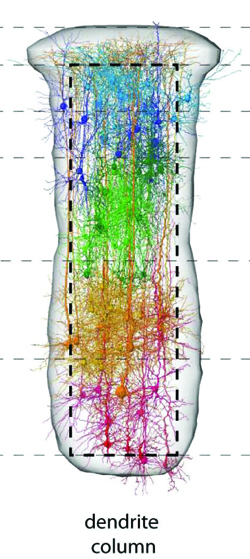
Collaboration between CNCR and Max Planck Florida Scientists created the first realistic three-dimensional diagram of a thalamocortical column in the rodent brain.
Using a conceptually new approach and state-of-the-art research tools, the first realistic three-dimensional diagram of a thalamocortical column in the rodent brain has been created. A vertically organized series of connected neurons that form a brain circuit, the cortical column is considered the elementary building block of the cortex, the part of the brain that is responsible for many of its higher functions.
This achievement is the first step toward creating a complete computer model of the brain, and may ultimately lead to an understanding of how the brain computes and how it goes awry in neurological, neurodevelopmental and psychiatric disorders. The study is published online in the journal Cerebral Cortex.

“This is the first complete 3D reconstruction of a realistic model of a cortical column,‚ said Marcel Oberlaender, PhD, first author on the paper. “This is the first time that we have been able to relate the structure and function of individual neurons in a live, awake animal, using complete 3D reconstructions of axons and dendrites. By creating this model, we hope to begin understanding how the brain processes sensory information and how this leads to specific behaviors.‚
Dr. Oberlaender and Dr. Christiaan de Kock contributed equally to this work. Marcel Oberlaender is part of the Max Planck Florida Institute’s Digital Neuroanatomy group, led by Dr. Bert Sakmann and Christiaan de Kock is with the CNCR and Neuroscience Campus Amsterdam, VU University Amsterdam, the Netherlands. The research team also included scientists from Max Planck Institute for Medical Research (Heidelberg, Germany), Columbia University and Zuse Institute (Berlin).
For more information please visit:
http://cercor.oxfordjournals.org/content/early/2011/11/16/cercor.bhr317.long
Related news items:
http://futureoftech.msnbc.msn.com/_news/2011/12/07/9281008-3-d-model-of-rat-brain-circuit-created
http://www.sciencedaily.com/releases/2011/12/111207132914.htm